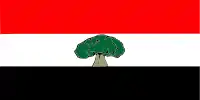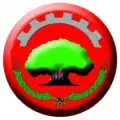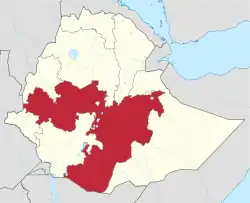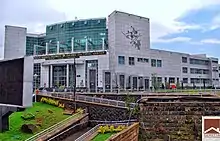Oromia Region
The Oromia Region (Oromo: Oromiyaa) is a regional state in Ethiopia, the homeland of the Oromo people. The capital city of the State of Oromia is Addis Ababa.[4] Currently the state consists of 21 administrative zones.[5][6]
Oromia Region
Oromiyaa | |
|---|---|
| Oromia | |
 Flag  Seal | |
 Map of Ethiopia showing Oromia Region | |
| Country | Ethiopia |
| Official language | Oromo |
| Capital | Addis Ababa[1] |
| Government | |
| • President | Shimelis Abdisa (Oromo Democratic Party) |
| Area | |
| • Total | 286,612 km2 (110,662 sq mi) |
| Area rank | 1st |
| Population (2018) | |
| • Total | 35,000,000[2] |
| Demonym(s) | Oromian |
| Time zone | EAT |
| ISO 3166 code | ET-OR |
| HDI (2017) | 0.448[3] low · 8th |
Towns in the region include Adama, Ambo, Asella, Badessa, Bale Robe, Bedele, Bishoftu, Begi, Bule Hora, Chiro, Dembidolo, Fiche, Gimbi, Goba, Haramaya, Holeta, Jimma, Metu, Negele Arsi, Nekemte, Sebeta, Shashamane and Waliso, among many others.
It is bordered by the Somali Region to the east; the Amhara Region, the Afar Region and the Benishangul-Gumuz Region to the north; Dire Dawa to the northeast; the South Sudanese state of Upper Nile, Gambela Region, Southern Nations, Nationalities, and Peoples' Region and Sidama Region to the west; the Eastern Province of Kenya to the south; as well as Addis Ababa as an enclave surrounded by Oromia Special Zone Surrounding Finfinne in its center and the Harari Region as an enclave surrounded by East Hararghe in its east.
The 2011 census reported the population of Oromia as 35,000,000; this makes it the largest regional state in population. It is also the largest regional state covering 286,612 square kilometers. Oromia is the world's forty-second most populous subnational entity, and the most populous subnational entity in all of Africa.
History
Oromia includes the former Arsi Province along with portions of the former Bale, Hararghe, Illubabor, Kaffa, Shewa and Sidamo provinces. Oromia shares a boundary with almost every region of Ethiopia except for the Tigray Region. This boundary has been disputed with Oromia's neighbors in a number of cases, most notably between Oromia and the Somali Region. One attempt to resolve the dispute between the two regions was the October 2004 referendum held in about 420 kebeles in 12 districts across five zones of the Somali Region. According to the official results of the referendum, about 80% of the disputed areas have fallen under Oromia administration, though there were allegations of voting irregularities in many of them.[7] The results led over the following weeks to minorities in these kebeles being pressured to leave. In Oromiya, estimates based on figures given by local district and kebele authorities suggest that 21,520 people have been displaced in border districts, namely Mieso, Doba, and Erer in the West and East Hararghe Zones. Federal authorities believe that this number may be overstated by as much as 11,000. In Doba, the Ministry of Federal Affairs put the number of IDPs at 6,000. There are also more than 2,500 displaced persons in Mieso.[8] In addition, there were reports of people being displaced in the border area of Moyale and Borena zones due to this conflict.[9]

On 12 September 2015 and continuing into 2016, protests broke out across Ethiopia and centered around the Oromia Region. Dozens of protesters were killed in the first days of the protests and internet service was cut in many parts of the region.
Ethiopian Airlines Flight 302 crashed in the woreda (district) of Gimbichu on 10 March 2019.[10]
Demographics
Based on the 2007 census conducted by the Central Statistical Agency of Ethiopia (CSA), Oromia Region has a total population of 13,993,933, consisting of 6,595,006 men and 6,398,927 women [these numbers are inconsistent with the historical population table below]; urban inhabitants number 3,370,040 or 11.3% of the population. With an estimated area of 353,006.81 square kilometers, this region has an estimated population density of 76.93 people per square kilometer. For the entire region 5,590,530 households were counted, which results in an average for the region of 4.8 persons to a household, with urban households having on average 3.8 and rural households 5.0 people. The projected population for 2017 was 32,815,995.[2]
In the previous census, conducted in 1994, the region's population was reported to be 17,088,136; urban inhabitants number 621,210 or 14% of the population.
According to the CSA, as of 2004, 32% of the population had access to safe drinking water, of whom 23.7% were rural inhabitants and 91.03% were urban.[11] Values for other reported common indicators of the standard of living for Oromia as of 2005 include the following: 19.9% of the inhabitants fall into the lowest wealth quintile; adult literacy for men is 61.5% and for women 29.5%; and the regional infant mortality rate is 76 infant deaths per 1,000 live births, which is about the same as the nationwide average of 77; at least half of these deaths occurred in the infants' first month of life.[12]
| Year | Pop. | ±% |
|---|---|---|
| 1994 | 18,732,525 | — |
| 2007 | 26,993,933 | +44.1% |
| 2015 | 33,692,000 | +24.8% |
| source:[13] | ||
Ethnic groups
| Ethnic group | 1994 Census | 2007 Census |
|---|---|---|
| Oromo | 91% | 92% |
| Amhara | 3.9% | 4.1% |
| other ethnic groups | -% | 5% |
Religion in entire region
| Religion | 1994 Census | 2007 Census[14] |
|---|---|---|
| Muslim | 47.3% | 47.6% |
| Orthodox Christians | 37% | 38.4% |
| Protestant Christians | 8.6% | 9.7% |
| Waaqeffanna | 4.2% | 3.3% |
| other religious groups | 1.6% | 1% |
Religion in urban areas
| Religion | 1994 Census | 2019 Census[14] |
|---|---|---|
| Orthodox Christians | 50.8% | 48.2% |
| Muslim | 40.2% | 38.8% |
| Protestant Christians | 8.6% | 9.7% |
| other religious groups | – | 1.5% |
Languages
Oromo,is written with Latin characters known as Qubee. Oromo serves as the official working language of Ethiopia[15] and is also the working language of several of the states within the Ethiopian federal system including Oromia,[16] Harari and Dire Dawa regional states and of the Oromia Zone in the Amhara Region. It is a language of primary education in Oromia, Harari, Dire Dawa, Benishangul-Gumuz and Addis Ababa and of the Oromia Zone in the Amhara Region. It is used as an internet language for federal websites along with Tigrinya.[17][18]
more than 33.8% Oromo speakers in Ethiopia and considered is the most widely spoken language in Ethiopia.[16] It is also the most widely spoken Cushitic language and the fourth-most widely spoken language of Africa, after Arabic, Hausa and Swahili.[19] Forms of Oromo are spoken as a first language by more than 35 million Oromo people in Ethiopia and by an additional half-million in parts of northern and eastern Kenya.[20] It is also spoken by smaller numbers of emigrants in other African countries such as South Africa, Libya, Egypt and Sudan. Besides first language speakers, a number of members of other ethnicities who are in contact with the Oromo speak it as a second language. See, for example, Harari, Omotic-speaking Bambassi and the Nilo-Saharan-speaking Kwama in northwestern, eastern and south Oromia.[21]
Economy

Oromia is a major contributor to Ethiopia's main exports - gold, coffee, khat and cattle. Lega Dembi in Guji Zone, owned by Midroc has exported more than 5000 kilograms of gold[22] followed by Tulu Kapi in Wollaga. Awoday in Hararghe is the biggest market of khat exporting to Djibouti and Somalia.[23] Oromia has also abundant livestock than any regions in Ethiopia including camels. It is also the largest producer of cereals and coffee.
The CSA reported that, from 2004 to 2005, 115,083 tons of coffee were produced in Oromia, based on inspection records from the Ethiopian Coffee and Tea Authority. This represents 50.7% of the total production in Ethiopia. Farmers in the Region had an estimated total of 17,214,540 cattle (representing 44.4% of Ethiopia's total cattle), 6,905,370 sheep (39.6), 4,849,060 goats (37.4%), 959,710 horses (63.25%), 63,460 mules (43.1%), 278,440 asses (11.1%), 139,830 camels (30.6%), 11,637,070 poultry of all species (37.7%), and 2,513,790 beehives (57.73%).[24]
According to a March 2003 World Bank publication, the average rural household has 1.14 hectares of land compared to the national average of 1.01 hectares. 24% of the population work in non-farm related jobs compared to the national average of 25%.[25]
Presidents of the Executive Committee
- Hassan Ali (1992–1995)
- Kuma Demeksa (OPDO) (1995 – 24 July 2001)
- Junedin Sado (28 October 2001 – 6 October 2005)
- Abadula Gemeda (6 October 2005 – September 2010)
- Alemayehu Atomsa OPDO (September 2010 – February 2014)
- Muktar Kedir OPDO (March 2014 – 2016)[26]
- Lemma Megersa (June 2016 – 2019)
- Shimelis Abdisa (2019–present)
Administrative zones
The Oromia is subdivided into 21 administrative zones:[5][6]
Arsi
Borana
Hararghe
Jimma
Shewa
- East Shewa
- North Shewa
- South West Shewa
- West Shewa
- Oromia-Finfinne (special zone)
Welega
See also
- Black Gold, film
- Ethiopian Ministry of Culture and Tourism
- List of districts in the Oromia Region
- Oromia Zone
References
- "FDRE States: Basic Information, Oromia". The Federal Democratic Republic of Ethiopia. Archived from the original on 17 June 2008. Retrieved 29 May 2008.
- Population Projection of Ethiopia for All Regions At Wereda Level from 2014 – 2018. Federal Democratic Republic of Ethiopia Central Statistical Agency. Archived from the original on 6 June 2018. Retrieved 4 June 2018.
- "Sub-national HDI - Area Database - Global Data Lab". hdi.globaldatalab.org. Retrieved 13 September 2018.
- "The State of Oromia". Archived from the original on 17 June 2008.
- "Oromia zone". oromiyaa.gov.et.
- "sirni hundeeffama Godina Baalee Bahaa". obnoromia.com (in Oromo).
- "Somali-Oromo border referendum of December 2004" Archived 30 April 2009 at the Wayback Machine, Internal Displacement Monitoring Centre website (accessed 11 February 2009)
- "Regional Overview: Oromia Region", Focus on Ethiopia (April 2005), p. 5 (accessed 11 February 2009)
- "Regional Update: Oromiya", Focus on Ethiopia Archived 5 March 2009 at the Wayback Machine (May 2005), p. 5 (accessed 11 February 2009)
- "Honoring the Victims with Traditional Memorial Service". Ethiopian Airlines. 22 March 2019. Retrieved 31 March 2019.
- "Households by sources of drinking water, safe water sources" (PDF). CSA Selected Basic Welfare Indicators. Archived from the original (PDF) on 18 November 2008. Retrieved 28 January 2009.
- Macro International Inc. Ethiopia Atlas of Key Demographic and Health Indicators, 2005 (PDF). Calverton: Macro International, 2008. 2008. pp. 2, 3, 10. Retrieved 28 January 2009.
- Oromia Region population statistics
- Census 2007 Tables: Oromia Region Archived 13 November 2011 at the Wayback Machine, Table 3.3.
- Shaban, Abdurahman. "One to five: Ethiopia gets four new federal working languages". Africa News.
- "The world factbook". cia.gov.
- http://www.mcit.gov.et/. Missing or empty
|title=(help) - "ቤት | FMOH". www.moh.gov.et.
- "Children's books breathe new life into Oromo language". bbc.co.uk.
- "Archived copy". Archived from the original on 25 August 2016. Retrieved 22 August 2016.CS1 maint: archived copy as title (link)
- Ethnologue (19 February 1999). "Languages of Ethiopia". Ethnologue. Retrieved 10 August 2013.
- "Ethiopian Gold Export Soars".
- "Khat is big business in Ethiopia".
- "CSA 2005 National Statistics – Tables D.4 – D.7" (PDF). Archived from the original (PDF) on 18 November 2008.
- Klaus Deininger; et al. "Tenure Security and Land Related Investment, WP-2991". Archived from the original on 10 March 2007. Retrieved 23 March 2006.
- Cahoon, Ben. "Ethiopian Regional States". www.worldstatesmen.org. Retrieved 27 March 2018.
External links
| Wikimedia Commons has media related to Oromia Region. |
